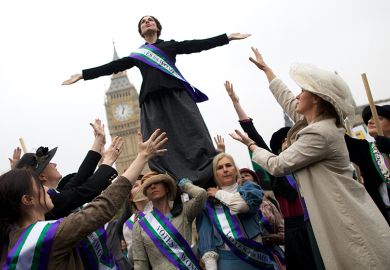On the principle that we are what we know, it is always interesting to learn what people read or have read.
In the 19th and early 20th centuries, when separate spheres for the sexes were being both celebrated and challenged, the appropriate reading matter for women - at home, school and college - was vigorously debated by a variety of commentators.
During this period, as educational provision and literacy increased and reading material became cheaper and more widely available, women established themselves as important consumers of literature, whose tastes were of interest to moralists and publishers alike. And since the end of the 18th century at least, writing was an acceptable occupation for women, so that the female reader was not simply courted by members of the opposite sex.
Male and female authors, concerned about the ignorance, suggestibility, emotionalism and precious purity of women, believed it was vital to protect young girls from unsuitable literature and to prepare them for their domestic destiny. That which was unsuitable often involved the depiction of female sexuality, but recent scholarship has established that there was more interest in sexual matters and the challenging of sexual stereotypes in Victorian and Edwardian times than once was acknowledged.
In addressing the subject of the female reader and the representation of female sexuality, the complementary studies of Kimberley Reynolds and Nicola Humble and of Kate Flint enlarge our knowledge of these contentious questions while making a case for the complexity of past debates and challenging simple generalisations about women readers. Thus if Victorians seeking certainty in an era of doubt and change classified women as either good or impure, a close analysis of literature and art, male and female authors, and material designed for different ages and classes allows Reynolds and Humble to reveal the unease that existed with such a neat division.
They convincingly argue that not all fictional women were seen as sexless: prostitutes and adolescent females were obvious exceptions to the rule, requiring special surveillance and treatment. Furthermore, the popular literary conventions of the orphan, to which women writers added their own gloss, provided heroines with new "physical and psychological" room for manoeuvre.
Reynolds and Humble also establish that the "new woman" literature of the end of the 19th century expressed a long maturing tension between the supposedly ideal sexless woman and a more assertive model: a tension still incapable of producing heroines undamaged by an association with sexuality, just as the more explicit depiction of women's bodies and dress still suggested women trapped and owned by male observers. The authors persuasively maintain that this discussion of active female sexuality was anticipated in the Decadent strain that penetrated Neoclassical representations of femininity by the 1860s, and in the "sensation" novels of the same decade. The joint authorship of Victorian Heroines works well and the book is attractively illustrated as well as strongly argued, though this reader was left wanting more on the fashionable topic of autobiography.
As it stands, the discussion does not show effectively that the portraits in the female versions were more "complex, sophisticated, innovative and satisfactory than their masculine counterparts", despite the points about the distinctiveness of women's presentation of the self being powerful ones.
In The Woman Reader, Flint gives us a comprehensive, meticulously researched and comparably well-illustrated account of her subject, examining writing of all kinds, painting and the work of modern theorists.
She looks at why Victorians and Edwardians devoted so much attention to female reading; at what was recommended and discouraged; at judgements on the effects of reading; and at its practice and location. A picture emerges of the variety of women readers in terms of class, religion and political allegiance, and of the heterogeneity of what they read. If it was assumed that women would be swayed by their reading and should therefore be directed towards material likely to uphold approved values and promote appropriate behaviour, Flint finds interesting evidence of faith in girls' innate purity.
In the same vein, she points up the eventual acceptance of novel reading; married women's freedom to choose what they read; alertness to gender issues; and the desire of women to share their reading experiences through autobiography and to demonstrate their equality with male writers through the careful use of quotations from respected texts.
While the importance of reading as escapism is conceded, there is a balancing discussion of the transgressive tendencies of "sensation" and "new woman" fiction, of their shared expectation of seriousness from the reader and of the differences between the two genres. In view of the prominence given to the "sensation" and "new woman" novels, the circumstances in which they appeared might have been more fully compared. But in general, attention to historical context is one of the many admirable features of The Woman Reader.
Christine Bolt is professor of American history, University of Kent, Canterbury.
The Woman Reader, 1837-1914
Author - Kate Flint
ISBN - 0 19 811719 1
Publisher - Oxford University Press
Price - £25.00
Pages - 366pp
Register to continue
Why register?
- Registration is free and only takes a moment
- Once registered, you can read 3 articles a month
- Sign up for our newsletter
Subscribe
Or subscribe for unlimited access to:
- Unlimited access to news, views, insights & reviews
- Digital editions
- Digital access to THE’s university and college rankings analysis
Already registered or a current subscriber?



